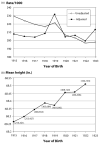Lingering prenatal effects of the 1918 influenza pandemic on cardiovascular disease
- PMID: 20198106
- PMCID: PMC2826837
- DOI: 10.1017/S2040174409990031
Lingering prenatal effects of the 1918 influenza pandemic on cardiovascular disease
Abstract
Prenatal exposure to the 1918 influenza pandemic (Influenza A, H1N1 subtype) is associated with ⩾20% excess cardiovascular disease at 60 to 82 years of age, relative to cohorts born without exposure to the influenza epidemic, either prenatally or postnatally (defined by the quarter of birth), in the 1982-1996 National Health Interview Surveys of the USA. Males showed stronger effects of influenza on increased later heart disease than females. Adult height at World War II enlistment was lower for the 1919 birth cohort than for those born in adjacent years, suggesting growth retardation. Calculations on the prevalence of maternal infections indicate that prenatal exposure to even uncomplicated maternal influenza may have lasting consequences later in life. These findings suggest novel roles for maternal infections in the fetal programming of cardiovascular risk factors that are independent of maternal malnutrition.
Figures


References
-
- Almond D. Is the 1918 Influenza pandemic over? Long-term effects of in utero influenza exposure in the post-1940 US population. J Polit Econ. 2006;114:672–712.
-
- Brown AS, Begg MD, Gravenstein S, et al. Serologic evidence of prenatal influenza in the etiology of schizophrenia. Arch Gen Psychiatry. 2004;61:774–780. - PubMed
Grants and funding
LinkOut - more resources
Full Text Sources

